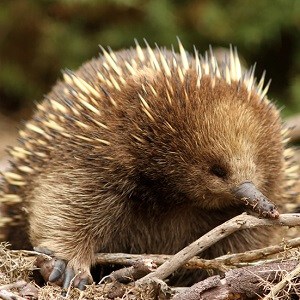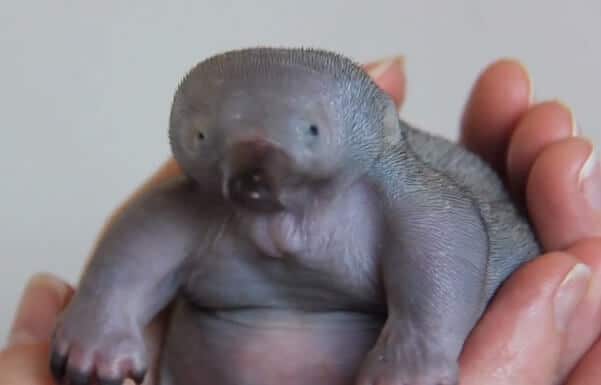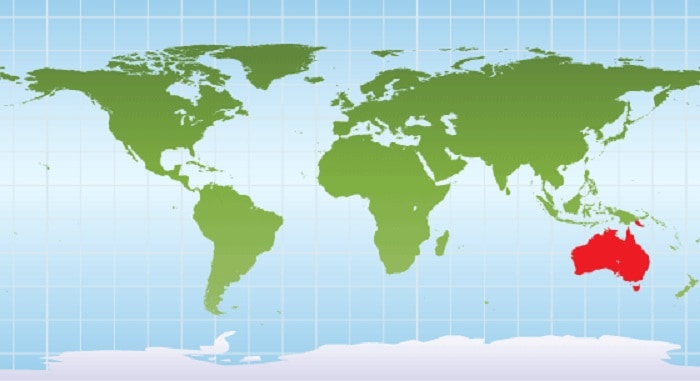Echidnas Have a Strange Collection of Features
One of the more bizarre echidna facts is that although echidnas are small mammals, they have several features you would ordinarily associate with other animals. They have the spines of a porcupine, the beak of a bird, the pouch of a kangaroo, and they lay eggs just like reptiles. Another trait similar to reptiles is that echidnas’ legs extend outwards, then downwards, causing them to waddle when they walk. Echidnas also have long claws that they use to dig straight down into the ground to escape predators, and dig burrows.
Echidnas’ Spines Are Modified Hairs
With the exception of their faces, legs and undersides, echidnas are covered by 2-inch (5 cm) long spines. One of the more surprising echidna facts is that these spines are in fact modified hairs. These long spines are cream in color and made from keratin, which is the same material that our fingernails consist of. These long spines are used as a form of protection. They also have short, coarse fur between the spines which provides them with insulation from cold weather.
Echidnas Are Carnivores – Without Teeth
Echidnas are carnivores, feeding on insects and small animals, such as ants, termites, worms and insect larvae. However, these carnivores have small mouths and toothless jaws. They use their long sticky tongues to catch their prey using rapid darting movements. Instead of teeth, echidnas have hard horny pads on the roof of their mouths and the back of their tongues to help them break down their food. Crunch! Yum!
Echidnas Have Huge Brains for Their Size
One of the more unusual echidna facts is that these little critters have very large brains for their small body size. This is due in part to the fact that they have an enlarged neocortex. The neocortex makes up 80% of the human brain, 30% of the brain in most other mammals, and an astonishing 50% of echidnas’ brains.
Echidnas Are Solitary Creatures
These small mammals are known to be solitary creatures. In fact, echidnas will only convene when it is time to mate. Generally, this occurs from July to August every year.
Echidnas’ Slow Metabolisms Increase Their Lifespan
Echidnas have a slow metabolism and a low body temperature. In fact, at just 89˚F (32˚C), echidnas have the lowest body temperature of all mammals. In addition, their body temperatures can vary by as much as 42 to 46˚F (6 to 8˚C) over the course of a day because their body temperatures are not regulated in the same way as other mammals. The combination of all these factors means that they have a long lifespan. One of the most astounding echidna facts is that echidnas can live up to an age of 50 years in captivity, and there are anecdotal reports that they can live as long as 45 years in the wild.
Echidnas Host the World’s Largest Flea
Echidnas host what is thought to be the world’s largest flea. The echidna flea, known as Bradiopsylla echidnae, measures approximately 0.15 inches (4mm) in length. Are you scratching yet?
Male Echidnas Have Four-Headed Penises
Yes, you read that correctly: male echidna have penises with four heads. During mating, two of the penises will shut down, while the other two will enlarge to fit into the female’s double-branched reproductive tract. The heads that are used vary from one mating session to the next. This is an adaptation for sperm competition because many male echidnas will attempt to fertilize one female. Another adaption is that the male echidnas’ sperm forms bundles which travel faster in the female’s reproductive tract than individual sperm cells.
Echidnas Have Rather Bizarre Mating Rituals, Including a Mating Train
Some of the most bizarre echidna facts relate to their mating rituals. At the beginning of the mating season, up to 12 male echidnas will line up nose to tail behind a single female echidna. This train can last up to a month, during which time some of the males will drop out, sometimes rejoining the train again. When the female echidna is ready to mate, the males in the train will respond by digging a trench around her. The males will then compete for the female, pushing each other out the trench. The last remaining male echidna is the one to receive mating honors. Sometimes, a male echidna will wake up early from hibernation, before mating season. It is likely that he will then sneak into a female echidna’s burrow and mate with her while she is still hibernating. Therefore, female echidnas sometimes wake up from hibernation, only to find themselves pregnant!
Echidnas Are Mammals, But They Lay Eggs
One of the more surprising echidna facts is that these mammals lay eggs. That’s because echidnas belong to the order of monotremes, a group of egg-laying mammals that are native to Australia. A female echidna will lay a small, soft-shelled leathery egg into her pouch. The baby echidna, called an echidna puggle, will hatch 10 days later.
Echidnas Have No Nipples, Yet They Feed Puggles Milk
Although echidnas are mammals and, as such, feed their young milk, echidnas don’t actually have nipples. Instead, female echidnas are equipped with special glands called milk patches. These glands are located in her pouch and secrete milk for her puggle to feed.
Echidnas Are Electro Receptive
One of the more shocking echidna facts is that these animals have an electro receptive system. In other words, the echidna uses its beak to detect the electric signals in insect bodies. This is an adaptation that helps it sense and find its prey quickly and efficiently. The echidna has 400 to 2,000 electro receptors on its snout. By way of comparison, the platypus (another animal with an electro receptive system) has about 40,000 electro receptors on its bill.
Echidnas Can Experience REM Sleep
It was long thought that echidnas did not experience rapid eye movement (REM) sleep, which is the stage of sleep when humans experience their dreams. However, recent echidna facts reveal that they do experience REM sleep, as long as the temperature is 77˚F (25˚C). If the temperature is higher or lower than this, then echidnas will not enter REM sleep at all.
One Species of Echidna is named after Sir David Attenborough
It is relatively easy to discern the difference between the two genera of echidna: short-beaked echidnas are smaller and have longer hair than their long-beaked counterparts. One species of long-beaked echidna, native to New Guinea, is named after Sir David Attenborough. This species is known as Zaglossus Attenborough. Nothing like rubbing shoulders with celebrities!
Echidna Facts – Facts about Echidnas Summary

Echidna Facts


No comments:
Post a Comment